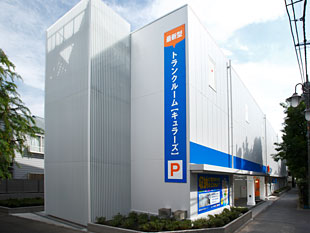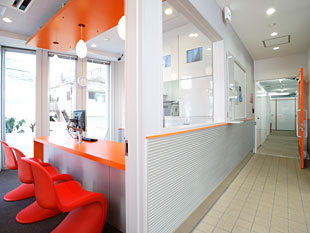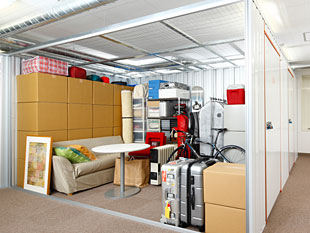Quraz Expands its Clout Centering on Metropolitan Areas
PM Editorial Desk: Coverage and Features
Quraz: Leading expansion of self-storage in Japan
“Self-storage,” which includes “trunk-room” or “rental-storage space,” is a generic term used to describe a space mainly intended for general consumers to store or house their personal belongings. Today in Japan, the self-storage industry is gradually gaining recognition among consumers and, as a new real estate investment product, leading to expansion of the market for this type of business. In recent years, attention to the industry has intensified in the aftermath of the Great East Japan Earthquake, for the use of self-storage in decentralizing the housing of furniture and valuables, as well as in stockpiling survival food for times of emergency. Views was able to interview Quraz, a market leader, regarding their perspective on what has made the self-storage market so attractive, and their strategies for the future.
Acquiring under-performing properties at low prices and operating them as their own property
In the United States where self-storage first appeared, approximately one in ten households uses self-storage. There are four REITs that specialize in self-storage, and their total market value at the end of 2011 well exceeded ¥2.0 trillion. Today, this sector is quickly becoming the focus of much attention because it has enjoyed the largest total return of all REIT classes for two consecutive years.
In Japan, a business model similar to that of today’s self-storage was started in the 1970’s. From the 1990’s to the 2000’s, a series of real estate companies made forays into the market (for details, refer to the column on p. 46). In Japan, the self-storage industry has gradually gained recognition among consumers and as a new real estate investment product, leading to expansion of the market for this type of business. Recently, in the aftermath of the Great East Japan Earthquake, attention to the industry has intensified with the use of self-storage in decentralizing the housing of furniture and valuables, as well as in stockpiling survival food for times of emergency. Against such a backdrop, Quraz, founded in 2001, is proud of their growth in both revenue and in their number of units (spaces), and is vying for the number one position in the industry. They have continued to expand their revenue at the astounding pace of approximately 20% per year for the past five years.
The business model for Quraz, established under financial contributions from The Baupost Group (an American investment company), is to acquire low-cost, under-utilized property in older office buildings located in residential areas. After receiving the right to change the use of a property to self-storage and completing the necessary renovations, they then operate the property as their own shop.
Quraz is expanding their shops throughout Japan; as of May 2012, it has 45 shops. Six of those shops are, or will be, newly opened this year. They are currently targeting mid-sized properties for acquisition, with total floor areas between approx. 990 and 3,300 square meters. Presently, they are focusing on locations in metropolises such as Tokyo and Yokohama, and on other core cities such as Sapporo, Osaka, Nagoya and Fukuoka. Because Quraz owns its property, they are free to change the interior and exterior of the buildings. Also, they are able to invest the funds they saved by purchasing low-cost property into remodeling those buildings. For that reason, Quraz’s strength that differentiates them from their competitors is in their ability to provide high-quality services that have a unified brand feeling, in all of their properties nationwide.
The maximum amount that they spend for purchasing and renovating one property is approximately ¥1.0 billion. They open their property for business anywhere between six and nine months after its purchase. This includes the time required for converting its use. They consider leasing to be complete within one to two years after a property is open for business. Thereafter, after operations have stabilized, they achieve 12 to 13% yield rates per year.

Their services have been highly praised for meticulous attention to the tangible and the intangible.
To use as an example of a shop and its services, the “Toritsu-Daigaku Shop” just opened along a National Route in Tokyo. This shop is five floors (above ground), has 740 units (over 100 units per floor), and includes a total of 15 different sizes of rental spaces. The spaces range in size from simple locker type “boxes” and 1.0 Tatami-mat (approx. 1.62 square meters) spaces that are 2 meters high and can store clothing or furniture; to 6.5 tatami-mat (approx. 10.53 square meters) space to allow temporary storage of luggage of various sizes when moving homes or changing office locations. Monthly rental fees range from ¥5,800 to ¥79,700. Customers can rent storage space for as short a period as one month, and the initial cost for becoming a member of a shop is only ¥1,575 that includes the creation of their elevator card key.
Furthermore, their meticulous attention to providing their customers with quality services, in both tangible and intangible ways, is proving to be very popular. These popular services include 24-hour access and parking. On weekdays, a concierge is always on duty. Security measures are also implemented, including card keys for access to each floor and padlocks with different types of keys for each space. This shop received approximately 200 inquiries within its first two weeks of opening. Sixty of those leads led to signed customer agreements.

High demand even in tough economic times, even in areas where square-foot prices are higher than office buildings?
90% of Quraz customers are individual consumers and the remaining 10% of their business comes from corporations. The types of use can be classified into three general patterns. One-third of their customers need long-term storage (two years or longer). These customers generally use storage space as an additional closet where they can keep seasonal clothing, golf clubs, surfboards, or their personal collections. Another one-third of their customers are short-term users (six months to approximately one year). Typically, these users temporarily store large furniture when they are moving or renovating a home. Another one-third of their customers are mid-term users (from six months to approximately two years). This type of storage user will take advantage of that space to make extra space in their homes, when they are getting transferred, getting married, or moving in with relatives.
The President and Representative Director, Stephen Spohn talks about the need for the storage service in Japan as follows. “The most commonly used storage space size is the 2.5 square meter unit. This is different than the United States where self-storage spaces are located in suburbs, and where the garage type of unit often over 10 square meters is used. It seems that our main customer in densely-populated, metropolitan areas use small spaces.” Furthermore, about the prospects for the self-storage business, Spohn raised the points of high profitability and being unaffected by economic trends.
He said “compared to renting office buildings, the rentable area drops to 70 to 80% of office due to the common space we need for unit access, but depending on the shop we rent space at approximately ¥10,000 or more per square meter. That amounts to approximately ¥35,000 to ¥40,000 for a 3.3 square meter space. This is a major strength of ours, compared to other property uses. Also, there is not even one shop that has experienced a drop in occupancy rate in the last three years. When the economy turns bad, there is a often a move to change homes or move to smaller offices. It is in such times that self-storage is even more essential.”


Also, because Quraz can offer higher quality services, both tangible and intangible, than other companies, they often have a slightly higher rental fee than nearby competitor shops. The fact that Quraz has sustained good growth rates until now, however, proves that many customers consider not only the price but also the quality of the services to be important.
Spohn added that they will develop another 20 shops over the next three years. He is confident that the market will continue to grow.
Self-Storage Industry in Japan
Differences in business category according to storage or non-storage
Currently, in Japan, there are three general classifications for the self-storage business. First is the so-called “trunk-room” that is managed pursuant to the Warehousing Business Act. These operators have a duty to indemnify customers for the stored property. Next is a class called a “rental-storage space” that uses rooms set up in a building or specialized facility for leasing. The last class is called a “rental-container” that is mainly setup outdoors for rental.
Furthermore, classes are often based on whether the agreement with the consumer is a “consignment agreement for property” (trunkroom) type or a “rental agreement for space” (rental-storage space, or rental-container) type. In many cases, consumers recognize the rental-storage space as the trunk room. Because of that fact, this article separates the indoor type “rental-storage space” and the outdoor type “rental-containers” to facilitate the reader’s understanding.
In Japan, the type that was initially used was the trunkroom type, which developed from the warehousing industry. As a typical example, in 1987, Oshiire Sangyo was created through the joint investment of twelve mid-sized warehousing companies and major corporations such as JT and NTT East Japan, and the like. It grew in size with the expansion of its franchise. Conversely, the rental-storage space and rental-container businesses have expanded over the past 10 to 20 years, mainly among real estate companies. An increasing number of companies are entering the market regardless of whether it is in metropolitan areas or in the suburbs. This comes from the viewpoint of effective use of land, utilization of empty offices in buildings, and diversification of profit sources. Major players in this industry include Arealink (established 1995) and REISE (establish 1991), which have based their profits on leasing a whole floor in a building, or on management and operating fees coming from property in which a landowner has invested. Both companies offer various brands including container types and specialized facility types, and are presently expanding the number of shops.
In 2006, much attention was given to a Mitsui & Co., Ltd. subsidiary, Storage Plus, entering the market. Quraz falls under the “rental storage space” classification as it owns properties and offers indoor type storage space as reported in this article..
Types of Self-Storage Businesses
| Type |
Trunk room |
Rental
Storage
space |
Rental
container |
| Agreement Format |
Consignment Agreement, whereby the operator accepts and maintains custody of the customer's property |
Space Lease Agreement |
Container Lease Agreement |
| Sales |
Amount of Items Stored |
Rental Fee Based on Space |
Rental Fee Based on Space |
| Regulatory Requirements |
Must Obtain Certification From the Ministry of Land, Infrastructure, Transport and Tourism, based on Warehousing Business Act |
None |
None |
| Placing Storage Items In and Taking Out |
Operator Must Be Present |
Customer self-service |
Customer self-service |
| Usage Hours |
During Storage Operating Hours |
Often 24-hours |
Often 24-hours |
| Duty of Indemnification |
Yes |
No |
No |
| Usage Rates |
Comparatively Expensive |
Depends on Space and services |
Comparatively Inexpensive |
The only statistics related to the self-storage business can be found in "Complete Research on the Expanding Storage Business Market” issue by the Yano Research Institute, Ltd. According to the latest survey conducted in 2011, the size of this market is ¥3.31 billion for trunk rooms (an increase of approximately 4.7% from last year), ¥20.04 billion (an increase of approximately 4.0% from last year) for rental storage space, ¥22.19 billion (an increase of approximately 3.9% from last year) for rental containers and ¥45.55 billion in total (an increase of approximately 4.0% from last year). Furthermore, there are approximately 7,000 locations , approximately 320,000 units (rooms), and approximately one in 170 households that use self-storage space. (Each value is an estimated figure based on surveys conducted by Yano Research Institute, Ltd.)
Consumer protection under continued trial and error
The warehousing industry, which focused only on a business-to-business format, has expanded its business to the trunk-room business to target the general consumer as a new business type. It has continued for some time to be a mixture of wheat and chaff for businesses. In response to this, in 1986, the Ministry of Land, Infrastructure, Transport and Tourism developed and executed the “stipulations for standard trunk-room services” and in 1991, the “rules for certifying trunk rooms.” Later in 1994, the ministry established the “certified trunk-room” standard and the “quality trunk-room" certification system in 2001 to promote consumer protection.
Conversely, however, no legal restrictions exist and there has been an increase in rental-storage spaces and rental-containers that do not have a duty to indemnify property. Amid such a situation, there are many instances where the names and characteristics of each business category are confused. There has been constant trouble between consumers and businesses that did not implement measures to prevent property damage, or decay such as through mold and the like, or that neglected to provide explanations beforehand.
In order to improve the situation, seven companies, including the Odakyu Electric Railway Co., Ltd., Oshiire, and RIESE established an industry association called the “Rental Storage Association of Japan” at the request of the Ministry of Land, Infrastructure, Transport and Tourism in 2003 (Quraz became a member in 2009). This association awards recommendation “seals” to shops of member companies that satisfy a certain level of standards, and also provides a specialized insurance system for member companies. The Japan Self-Storage Association, whose members include Arealink Co., Ltd., was also established in 2010, indicating a trend in the industry to develop collaborative relationships among companies.
The self-storage industry had been one of the few growth sectors in the real estate industry, but it is now clear that the early days of easy profit simply by opening a shop are over. Today, high-quality services are in demand.